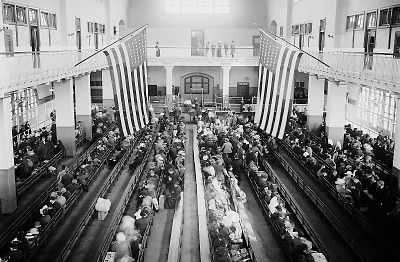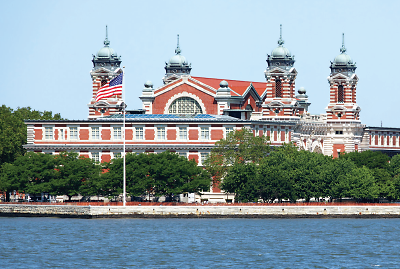“Immigration is not just a link to America’s past,” former President George H.W. Bush said, “it’s also a bridge to America’s future.”
The immigrant experience is a central component of the history of New York City, where 12 million immigrants passed through Ellis Island between 1892 and 1954. The descendants of those immigrants account for almost half of the American population today.
Declared part of the Statue of Liberty National Monument in 1965, Ellis Island underwent a $162 million renovation in the 1980s and reopened to the public as a museum in 1990, commemorating immigrants’ stories and their pursuit of a new home and the American Dream.
The museum is located in the Main Building of the former immigration station complex, now restored to its 1918-1924 appearance in the Renaissance Revival style. History buffs who really want to take in the immigrant experience will want to couple a visit to Ellis Island with one to the Lower East Side Tenement Museum (see story below).
The museum contains 30 galleries and exhibits filled with artifacts, historic photos, posters, maps, oral histories, and ethnic music recordings. New at the museum are two exhibits that bookend the Ellis Island era by chronicling immigration to America before the processing station opened in 1892 and after it closed in 1954: “Journeys: The Peopling of America 1550s-1890” is an exhibit dedicated to exploring the earliest arrivals pre-dating the Ellis Island era. The galleries, located in the historic Railroad Ticket Office, cover each stage of the immigrant journey. “The Journey: New Eras of Immigration” focuses on immigration from 1954 to the present. Exhibits use dynamic media and interactive elements to described the postwar immigration movement and changing demographic trends over the decades.
Permanent highlights of the museum include the Baggage Room, where immigrants first set foot into the Main Building on Ellis Island, now restored with displays of period baggage. The Registry Room, once the focal point of the immigrants’ processing, is where newcomers underwent questioning and were either given permission to land or denied entry into the country.
Here are some other features of the museum:
•
The American Family Immigration History Center is an interactive area where visitors can access the passenger records of the ships that landed over 51 million immigrants, crew members, and other travelers at the Port of New York and Ellis Island from 1892 to 1957.
•
The American Immigrant Wall of Honor overlooks the Statue of Liberty behind a view of the New York City skyline. It is the only place in the United States where an individual can honor his or her family heritage at a national monument.
•
The American Flag of Faces is located in the museum’s main entrance hall and is populated with images uploaded by individuals and families, creating a montage of the American flag.
•
“Island of Hope, Island of Tears” is a 30-minute film produced by Oscar-winning filmmaker Charles Guggenheim in which immigrants tell their stories of pulling up roots and coming to America. Free tickets can be obtained at the Ellis Island information desk.
•
The Ellis Island Oral History Project has been conducting interviews since 1973. More than 1,500 interviews have been collected of firsthand accounts of those who were processed at Ellis Island. There are also a number of interviews with doctors, nurses, clerks, and immigration officials who recall the operation of the Ellis Island immigration facility. The Oral History Library is open to the public and contains a computer system with 20 listening stations. The American Family Immigration History Center provides access to ships’ passenger manifest records of the millions of people who entered America through the Port of New York and Ellis Island. ■
To visit the Statue of Liberty and Ellis Island, visitors must take the Statue of Liberty and Ellis Island Ferry from Battery Park in lower Manhattan. Ticket information for individuals or groups is available online at Statue Cruises or by phone at 1-(877) LADY-TIX. Tickets also may be purchased
here.


